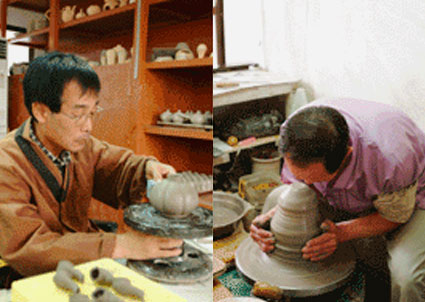Hand-Molding
If the soil is dried well, it is moved to grinding room to be moisturized until it becomes glutinous. The grinded soil is then broken into smaller pieces to be grinded over and over again until the air bubbles that were trapped inside are all out. Then it is ready for forming
If the soil is not grinded well before forming, the air within will expand and protrude during molding.
The most common method for forming is the potter's wheel. After forming, it is adequately dried to be mounted on the wheel again for patterning. This is when inlaying and patterning take place.

The most important thing at this stage is adjusting the thickness. The way to measure the thickness is by tapping, pressing, and touching both inside and outside. Experts prefer the tapping method.After forming the pieces are moved to another room to be inlaid with various patterns using diverse methods.
Apart from the wheel forming, mimicking enables to mimic a certain sacred object. This method is used for making tea pots, pillows, and other pieces that cannot be made through potter's wheels. Plaster enables mass producing of the same shape in a short time. Of course patterns could be added here too.

